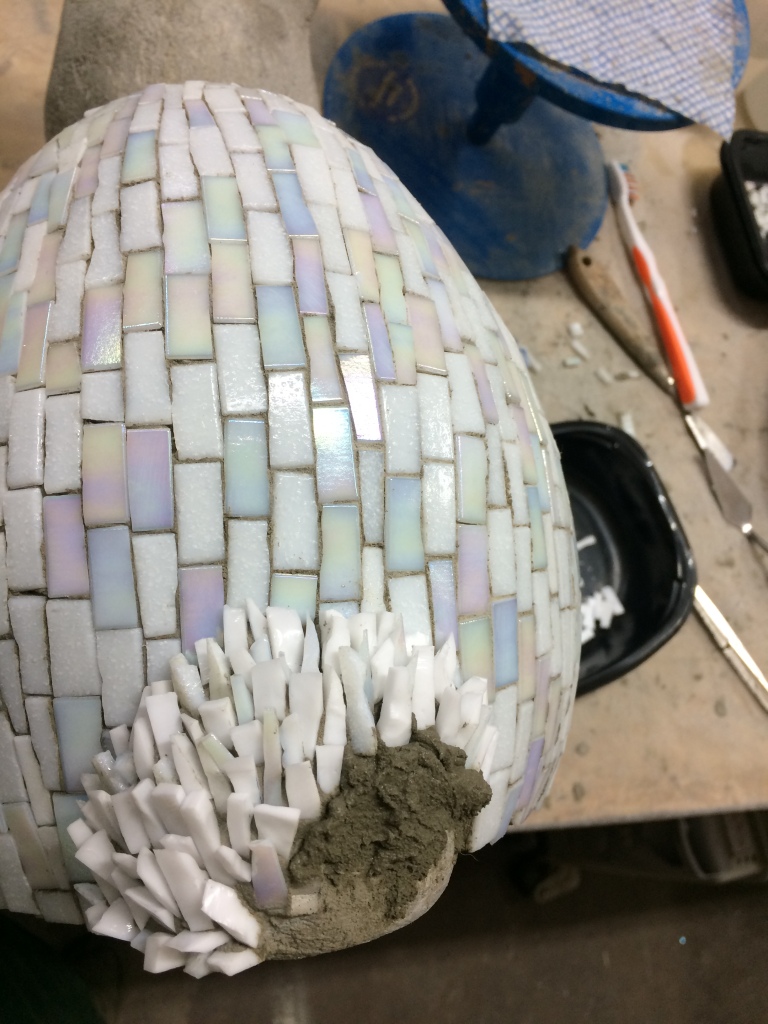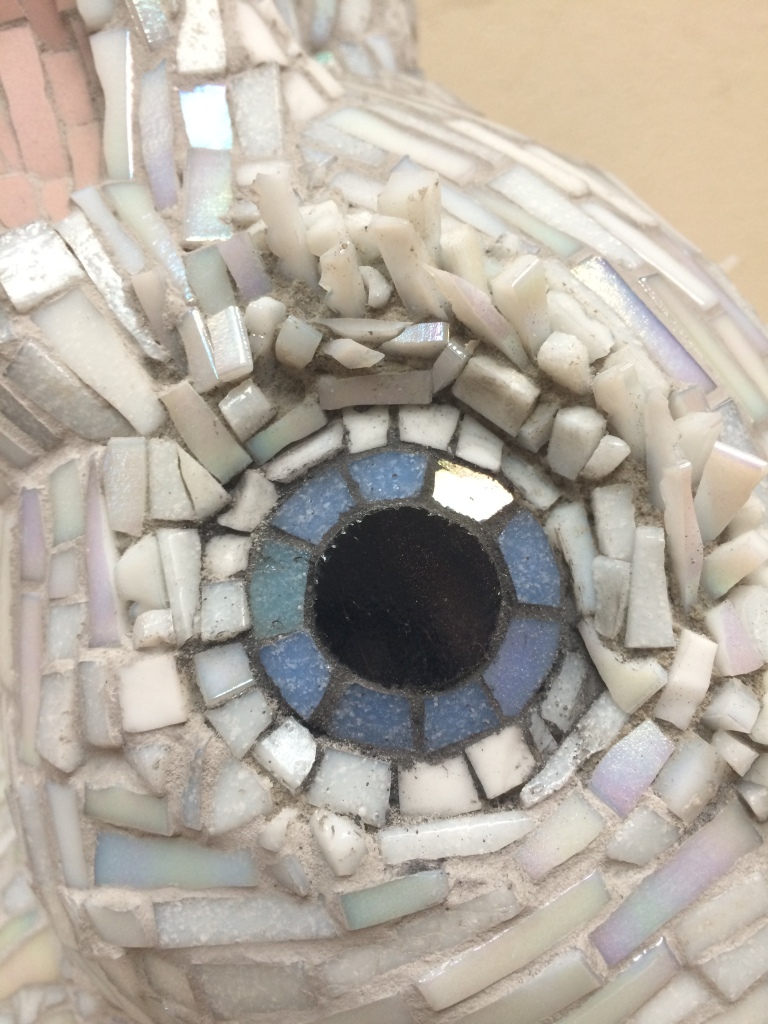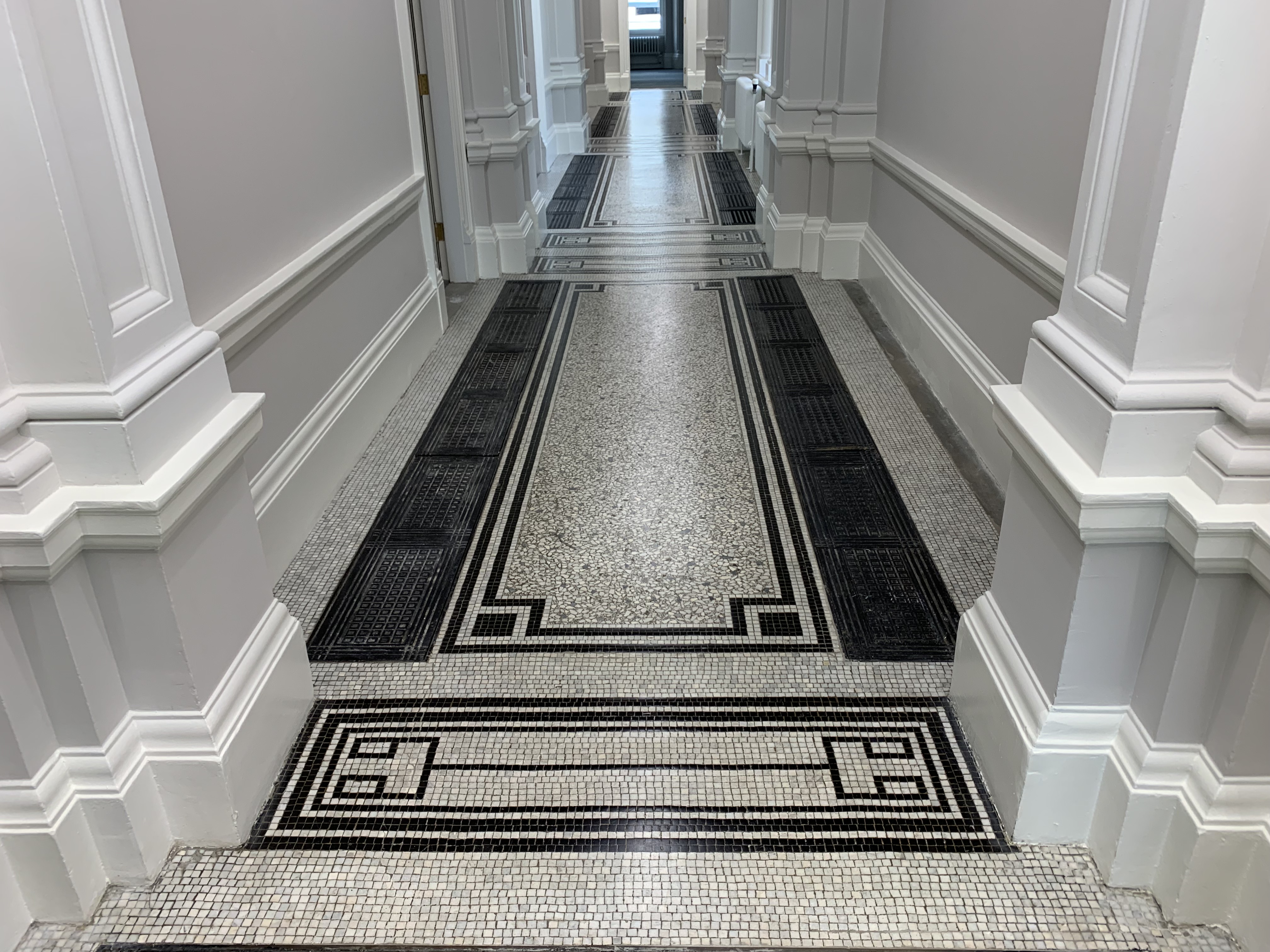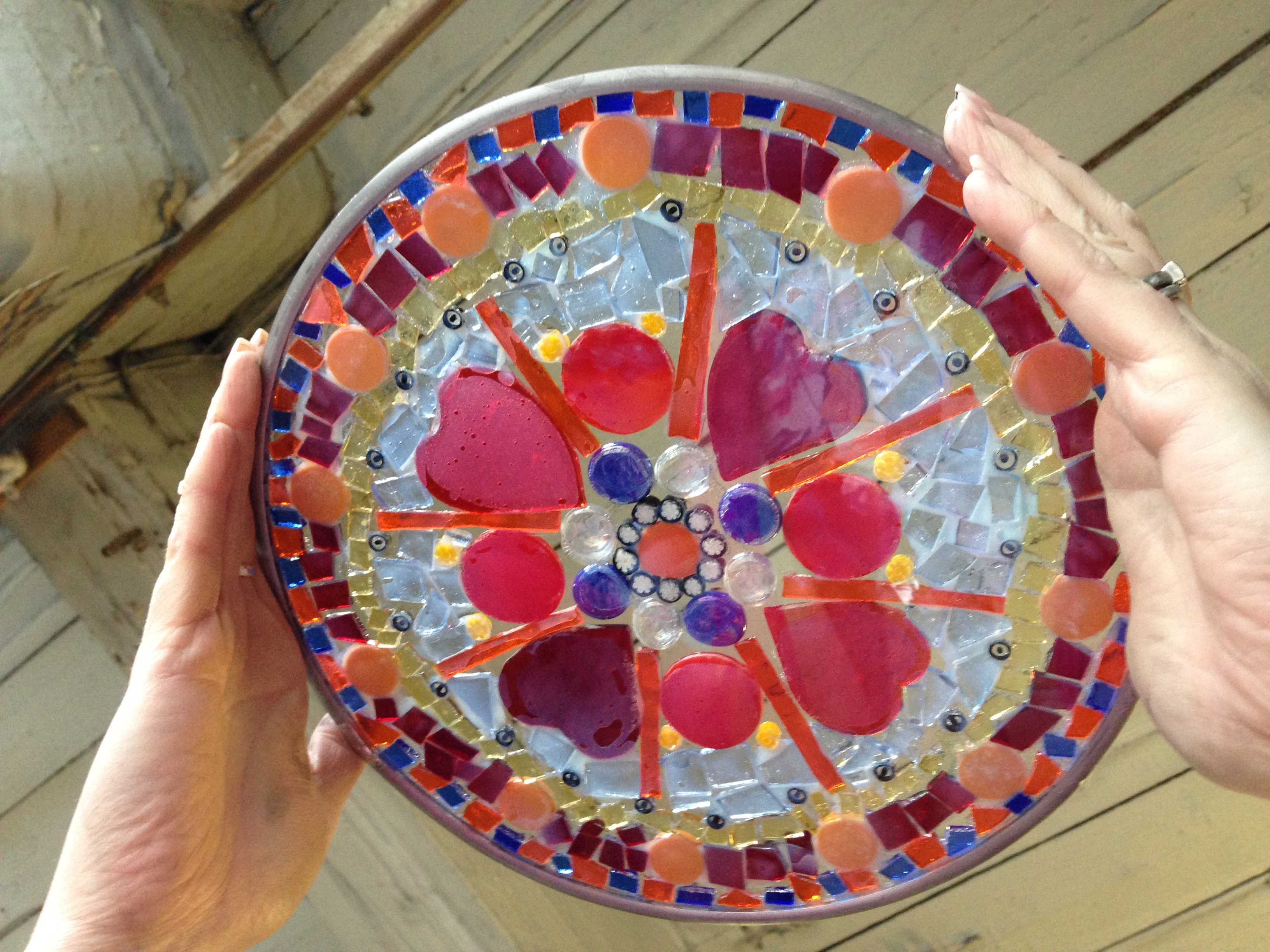Background

My journey into the fascinating world of mosaic has been, as career paths often are, determined principally by chance. Within two months of graduating with a Fine Art degree, I was delighted to be offered employment with a Manchester based environmental art organisation (Partnership Art Limited) that specialised in designing and installing works of art for public sites. Whilst there, I met artist Peter Hatton. Peter recruited me as his assistant for a project to engage with a community in Salford and produce and install a robust outdoor pavement mosaic in a local park. I loved every aspect of the work and learned the skills involved very quickly.

Installing Public Art Mosaic in Davyhulme Park, Urmston, Manchester 1992, for Chryslais Arts.

The mosaic sections were made by local people in workshops and cast into sections in the park pavillion.
More opportunities followed and within five years I had installed community mosaic pavement features in various towns and parks throughout the north west, accepting commissions in my own name as a self-employed professional artist as well as working on behalf of West Yorkshire public art organisation, Chrysalis Arts. Concurrently, I collaborated with many different artists, sculptors and community groups to design, produce and install a wide variety of other types of public art, mainly for city centres and urban environments.

Work off site for the Victoria Station Mosaic Floor Restoration, 2014.
Having especially enjoyed the mosaic medium, I went on to find training opportunities with experts across the UK and abroad to develop my abilities and know-how in a variety of mosaic techniques and applications. One of the most influential of these was the one-to-one workshop with Lawrence Payne, which provided me with a fundamental understanding of the key principles in ancient mosaics, also relevant to mosaic floors in the neo-gothic architecture of the Victorian era. So, when I was first asked to quote for the restoration of a mosaic floor, it became apparent to me that all my experience of working on construction sites to install public art combined with the mosaic skills I had gradually acquired and my active interest in mosaic conservation made this a completely natural career progression.
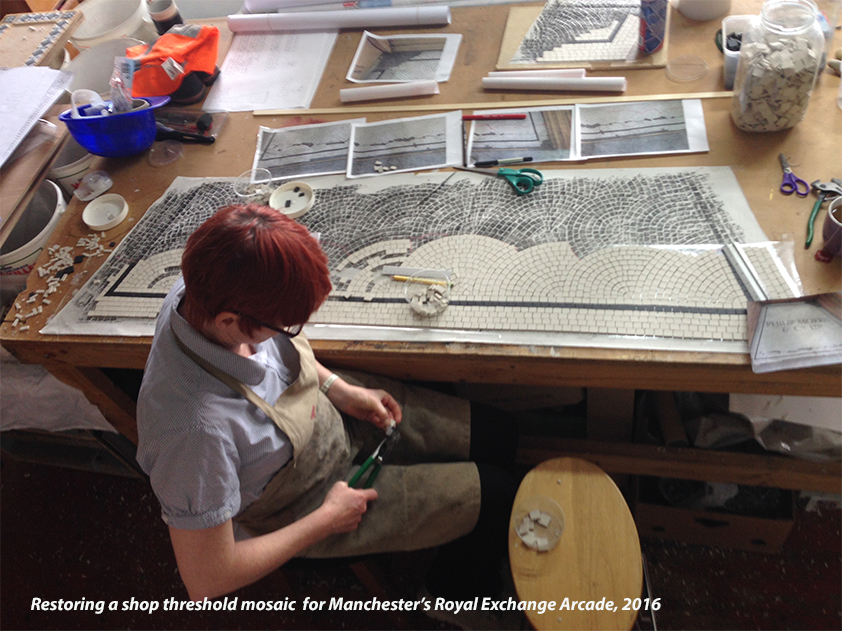
In 2014, I won a substantial contract to repair the mosaic floors at Victoria Rail Station in Manchester as part of its £44m heritage restoration (featured in Grout 46) and since then I have worked more frequently in the field of mosaic conservation, learning on the job. However, without a formal education in this area of work, I decided last year that it was time to acquire some proper training with the nation’s leading experts. So, I approached both Cliveden Conservation and The Mosaic Restoration Company to ask about a potential work placement. They both responded with an enthusiastic ‘yes’.
Summer Placement with Cliveden Conservation 2019
Cliveden Conservation was established in 1982, originally “for the preservation of the National Trust Buildings and Statuary”. Since then it has grown into a bigger operation with three workshops, specialising in the conservation of both external and internal architectural features, historic objects, monuments and statuary. At the time of my application to them, a significant mosaic floor conservation project for a royal property in London was already underway in their Taplow workshop. Cliveden extended a warm welcome for me to join the mosaic team and I was successful in receiving a bursary to cover the cost of the placement from the York Foundation for Conservation and Craftsmanship.
Prior to my arrival in August 2019, the mosaic floor had been painstakingly lifted from its site and was now being stored on purpose built storage racks within the mosaic conservation workspace. The stage of work in progress involved the removal of the cambric and foam-board facing materials, the cleaning and fixing of missing and displaced tesserae followed by grouting, on a section by section basis.

Sections of the mosaic floor stored during conservation work, Cliveden Conservation, Taplow, Berkshire. Photo Tracey Cartledge
During my two weeks with Cliveden, the project manager, Ben Roberts, provided a slideshow presentation to illustrate and explain the stages of the project that had been carried out before I joined the team. The mosaic had been discovered during structural investigations to explore the source of water ingress from the porte-cochère of the building in question in 2017.
The mosaic floor was hidden between the upper layers of modern resin asphalt and concrete and the screed beneath. Another company – DBR Conservation – carried out a series of trials, surveys and investigations to inform a report that summarised findings and put forward recommendations and a schedule of works was drawn up for pricing. Based on their proposed methodology, schedule and quotation, Cliveden was the successful recipient of the contract.
The team arrived on site in August 2018 with spades and began popping off the asphalt top layer. Pneumatic hammer drills were required to break out the thick course of concrete below the asphalt which was very tough work, by all accounts. Finally, the cement residue was chipped off to reveal a most stunning marble mosaic.
The square central panel, made up of black and white marble tesserae, depicts Neptune holding a trident in his right hand and a baby dolphin in the left, surrounded by four larger dolphins, positioned diagonally across each corner. A large field of Bianco Carrara tesserae, interspersed with short wavy lines of Nero Assoluto surrounds the central panel filling the rest of the floor, framed by a geometric border incorporating a black (Nero Assoluto) and yellow (Giallo Siena Intenso) guilloche. Outside the border is a wide band of random mix Giallo, Siena Intenso and a veined and varied grey marble. Finally, in a couple of places along the perimeter, there are door threshold panels featuring a red marble – possibly Rosso Alicante.

Photograph showing the border of the mosaic floor and adjacent door threshold panel (right), courtesy of Cliveden Conservation.
Removing the mosaic from site was a formidable operation carried out under the supervision of Historic England. First, two separate reference grids were made: a grid of wavy lines to indicate the cut lines for lifting and a grid of straight lines for the photo documentation. Each section was photographed from above. Then Dremel tools were used to cut out all the tesserae along the wavy seamlines of the cutting grid, creating panels approximately 600mm x 600mm. The loose tesserae were labelled (using tippex) and stored carefully for later in labelled tubs. All the outer panels, having been faced with cambric and foam board, were then lifted using slate rippers, one by one, until only the central dolphin panel remained.
There was harder mortar and brick rubble beneath the centre section of mosaic floor. Following discussions with a structural engineer, it was decided that this should all be lifted in one piece and the team improvised an elaborate plan to achieve this. A specialist drilling company was brought in to drill laterally beneath the central mosaic area with core drills. Fourteen cores were left in place to form a rig to support the floor as it was subsequently lifted using a block and tackle at each corner. It must have been an amazing moment when the whole of this mosaic floor centre was successfully raised up and then fitted into its purpose-built crate for transportation.

In the workshop, I met the team of conservators working systematically on the sections of mosaic floor, starting with Adrian, who was busy removing the foam-board and cambric facing from the surface of each section. I was involved in the next part of the process, repairing the panels, overseen by Amelia. The first panel that I was presented with had a series of spaces where tesserae were missing. The preparation involved chiselling out the lime mortar in these spaces to a suitable depth right up to the adjacent mosaic pieces followed by fastidious cleaning and sorting of the salvaged tesserae. The mortar bed had to be kept damp all the time so that freshly mixed mortar would make a good bond with it.

The prepared area ready for detatched tesserae to be reinstated
Unsurprisingly, the chiselling of the mortar prompted further tesserae to loosen, so that the spaces to be filled kept growing. When the preparation work was finally complete, I began recreating the missing areas of mosaic using a combination of salvaged tesserae as far as possible and newly cut stone when required. All this work was documented and the time spent carefully recorded.

We used a hammer and hardie for cutting lengths of sawn new stone down to size. The hardie was a bench top version, unlike the hardies I have used previously. Following Amelia’s advice, I had taken a good selection of small hand tools with me, which included side-biters for further trimming the tesserae and painter’s palette knives that were perfect for mixing and applying small quantities of mortar. We used a specialist mortar “Adhere Cal” by SecilTek, formulated exclusively from natural hydraulic lime for the restoration industry. I had a set of wax modelling tools with me that proved useful as ‘nudging sticks’. On-the-spot improvisations, such as making paper templates and creating curved mini retainer walls out of foam-board, held temporarily in position with clay, created helpful solutions within the fixing process.


Steady Progress
In total, I repaired three mosaic panels during my two-week placement. The days were blissful in the summer light, beginning at 7.30am and usually finishing around 5.00pm. During the two weeks, different people worked alongside me and on some days, I was working alone, due to the variety of other commitments the conservators on the mosaic team were involved with. There was ample free time outside our hours in the workshop to find out about other interesting projects going on at Cliveden and to check out the Anthony Caro open air exhibition in the grounds of the neighbouring Cliveden House (National Trust) property.

Michael Rysbrack Pegasus being repaired in the stone conservation studio.Photo Tracey Cartledge

Sculpture yard, Cliveden Conservation Taplow Workshop. Photo Tracey Cartledge

Anthony Caro Open Air Exhibition at Cliveden House Estate. Photo Tracey Cartledge
The most significant benefit of this placement was to see at first hand the approach taken in this type of mosaic floor conservation project from the beginning almost through to completion. I gained a clear insight into Cliveden’s techniques for lifting a large mosaic floor in sections and transporting it to their workshop, operating within a specific set of constraints. The hands-on work that I assisted with in the workshop brought new experiences such as working with hydraulic lime mortar and keeping a constant record of time spent on every task. This is important for evaluation purposes, monitoring costs and providing useful information when quoting for future projects.
In my next post I will report on my second work placement of summer 2019, working with The Mosaic Restoration Company.
























